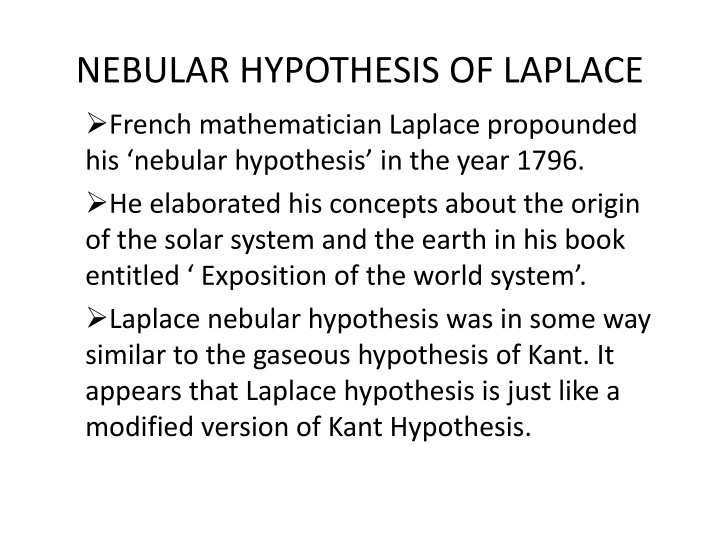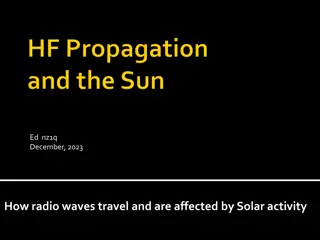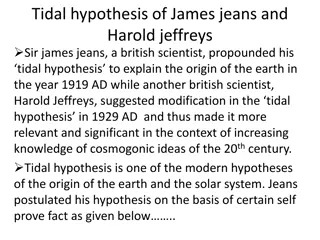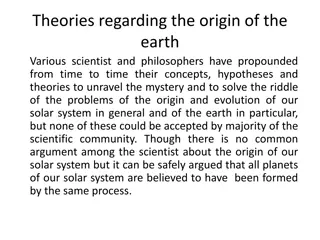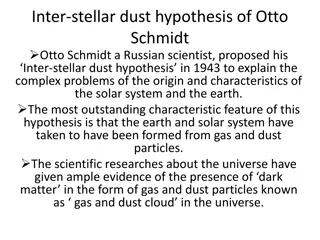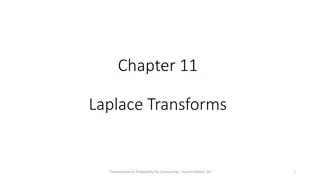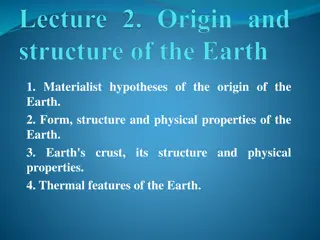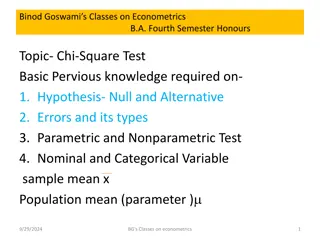Laplace's Nebular Hypothesis: Origin of the Solar System
French mathematician Laplace proposed the nebular hypothesis in 1796, refining Kant's gaseous hypothesis. Laplace asserted a hot rotating gaseous nebula cooled gradually, contracting and increasing rotation speed. Eventually, centrifugal forces led to the formation of ring structures, contrasting with Kant's nine-ring concept.
Download Presentation

Please find below an Image/Link to download the presentation.
The content on the website is provided AS IS for your information and personal use only. It may not be sold, licensed, or shared on other websites without obtaining consent from the author.If you encounter any issues during the download, it is possible that the publisher has removed the file from their server.
You are allowed to download the files provided on this website for personal or commercial use, subject to the condition that they are used lawfully. All files are the property of their respective owners.
The content on the website is provided AS IS for your information and personal use only. It may not be sold, licensed, or shared on other websites without obtaining consent from the author.
E N D
Presentation Transcript
NEBULAR HYPOTHESIS OF LAPLACE French mathematician Laplace propounded his nebular hypothesis in the year 1796. He elaborated his concepts about the origin of the solar system and the earth in his book entitled Exposition of the world system . Laplace nebular hypothesis was in some way similar to the gaseous hypothesis of Kant. It appears that Laplace hypothesis is just like a modified version of Kant Hypothesis.
Some basic facts of Laplace nebular hypothesis Laplace postulated his hypothesis after removing the inherent weak points and erroneous concept of Kant s hypothesis which suffered from three basic defects eg.1) Large amount of heat can not be generated due to the collision of cold particles of primordial matter. 2) Mutual collision of particles can not generate motion in the primordial. 3) The rotatory speed of the nebula cannot increase due to increase in the size of nebula.
In order to remove the aforesaid defects Laplace assumed certain fact He assumed that there was a huge and hot gaseous nebula in the space. From the very beginning huge and hot nebula was rotating on its axis. The nebula continuously cooling due to loss of heat from its outer surface through the process of radiation (due to circular motion or rotation of the nebula) and thus it was continuously reducing in size due to contraction on cooling. Thus, gradual loss of heat resulted into the cooling of the outer surface of nebula.
Gradual cooling caused gradual contraction in the size and volume of nebula. Thus reduction in the size and volume of the nebula increased the circular velocity (rotatory motion) of the nebula. In the next stage, as the size of nebula continued to decrease, the velocity of rotatory motion continued to increase. The result is that, the nebula started spinning at very fast speed and consequently the centrifugal force became so great that exceeded the centripetal force.
When this stage was reached the materials at the equator of the nebula became weightless. Consequently, the outer layer was condensed due to excessive cooling and so it could not rotate, after that process the central nucleus of the nebula and thus the outer ring (layer) was separated from the remaining part of the nebula. This separated ring of material started moving around the nebula. It is to be remembered that according to Laplace only one ring of material was separated from the nebula and not nine ring conceived by Kant.
Laplace further maintained that the original ring was divided into nine rings and each ring moved away from other ring. Thus nine planets were formed from nine rings and the remaining central nucleus of the nebula became the sun. Satellites were formed from the planets due to repetition of the aforesaid processes mechanism.
